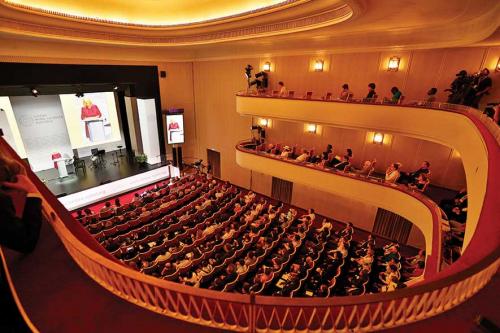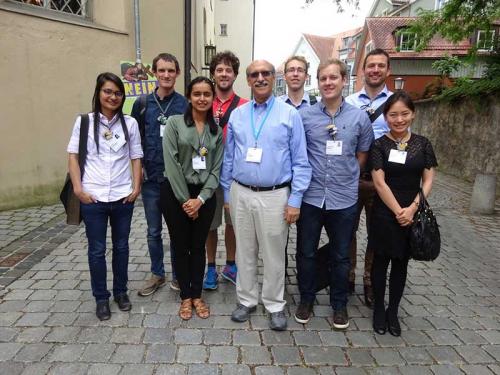Situated about 200 kilometres south-west of Munich, the city of Lindau on Lake Constance borders Austria’s and Switzerland’s mountains. Lindau is the place where the concept of the Nobel Laureate Meeting began. With a vision to reconnect German scientists to researchers around the globe, two Lindau physicians, Franz Jarl Hein and Gustav Wilhelm Parade, and Count Lennart Bernadotte af Wisborg organised the first Lindau Nobel Laureate Meeting in 1951. Over the past 67 years the meeting has thrived to educate, inspire and connect more than 32 000 young researchers.
This year’s June meeting gathered 28 Nobel laureates and 420 young scientists from more than 70 countries. I was lucky to be one of the nine early career researchers in chemistry selected by the Australian Academy of Science, the Science and Industry Endowment Fund and the Lindau Council to represent Australia and discuss and develop ideas addressing pressing worldwide issues. Unlike other conferences that I have attended, the Lindau Meeting was set so as to maximise the interactions of young researchers with each other as well as with Nobel laureates. At the registration, I received my personalised one-week agenda packed with science breakfasts, lectures, discussion sessions, master classes, panel discussions and academic dinners.
The extraordinary week started off with the inspiring keynote address of Professor Steven Chu (James H. Clark Center, Stanford University) (delivered by Professor William Moerner, Department of Chemistry, Stanford University) on the effects of climate change and the need for scientists to work together as well as with the general public, the private sector and policymakers to remedy the aftermath of cumulative human-made carbon dioxide levels. The importance of uniting skills from diverse backgrounds to form an intergenerational network of multidisciplinary collaborators without borders was a recurring theme and the Lindau Nobel Laureate Meeting provided a perfect platform to do so.
Among the educative discussions addressing current research findings were opportunities to interact with industry researchers. On 28 June, I was invited to the Mars Incorporated sponsored Science Breakfast ‘The chemistry of food: flavor and beyond’ and the Academic Dinner ‘The chemistry of the gut microbiome’ – both key aspects of my research. The talk from Dr Anita Zaidi (director of Enteric and Diarrheal Diseases (EDD) program at the Bill and Melinda Gates Foundation) was a particular eye-opener. As a recent PhD graduate, I found being exposed to the process of transitioning from laboratory research to its implementation in larger societies, in Anita’s case working on eliminating children’s mortality from diarrhoeal diseases in low–middle income counties, inspiring and it demonstrated a real-world application with positive societal impact.
My favourite memorable experience of the meeting was during the Gala dinner organised by Mexico. I was seated next to Professor Johann Deisenhofer (Green Center for Systems Biology, Biophysics, University of Texas Southwestern Medical Center), who received the Nobel Prize in Chemistry in 1988 for the determination of the three-dimensional structure of a photosynthetic reaction centre. The conversation flowed smoothly, we shared insightful perspectives of secondary and tertiary STEM education and research across continents, equity, the increase in nationalism around the planet and (his observations on) how far we have come compared to 60 years ago. Johann’s lifelong experience was invaluable and although I didn’t realise it at that time, the conversation enhanced my knowledge of international research and encouraged me to think about present-day trends in mobility, collaboration and transparency in science.
When asked for advice, the Nobel laureates generously shared their experience through their scientific/life challenges, their boldness to try a project highly important but almost impossible to achieve and their perseverance to explain unexpected results. One of the most impactful take-home messages was Sir John Walker’s anecdote about the importance of mentors in the career development of a young scientist:
[Sanger] encouraged me, gave me space, he simply supported me, he didn’t tell me what to do, he didn’t suggest that I work in this particular area but through his interest in mitochondrial DNA I got interested in bio-energetics. It can be advantageous and helpful to have brilliant, helpful and sympathetic mentors. So do your best to find one.
The trip to the 67th Lindau Nobel Laureate Meeting was a rich experience that contributed to my career aspirations, research and personal life. Hearing firsthand from the Nobel laureates’ experience in science, the way they learned from their mistakes and their advice to young scientists were unique experiences and I encourage other young scientists to apply for and attend future Lindau Nobel Laureate meetings.
Acknowledgements
I would like to thank the Australian Academy of Science, the Science and Industry and Endowment Fund, the Robert Bosch Foundation and the Lindau Council for sponsoring my attendance to the 67th Lindau Nobel Laureate Meeting. A huge thank you to Maria Forsyth (our delegation leader), Michael Taylor, Siddulu Talapaneni, Vini Gautam, Andrew Giltrap, Joy Jiang, Matthew Norris, Joseph Richardson and Andrew White for making this journey a fun and memorable one.





